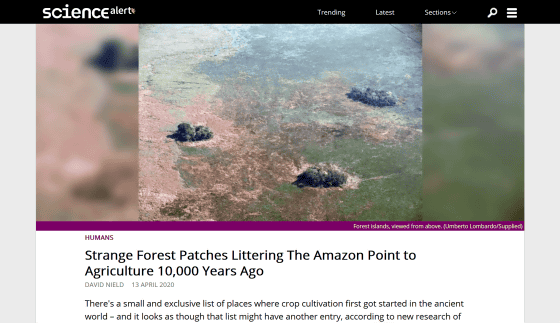`` Small forests '' scattered in the Amazon basin turned out to be a trace that agriculture was done over 10,000 years ago

by Umberto Lombardo
Early Holocene crop cultivation and landscape modification in Amazonia | Nature
https://www.nature.com/articles/s41586-020-2162-7
Evidence of 10,000-Year-Old Crops Points to the Amazon as an Early Agricultural Hotspot
https://gizmodo.com/evidence-of-10-000-year-old-crops-points-to-the-amazon-1842749202
Strange Forest Patches Littering The Amazon Point to Agriculture 10,000 Years Ago
https://www.sciencealert.com/the-amazon-basin-was-an-ancient-agricultural-hotspot-10-000-year-old-evidence-says

A small forest in the Mophos grassland in the southwestern Amazon Basin is several feet (tens of centimeters to several meters) higher than the surrounding ground, and there are more than several thousand in total. doing. Researchers have thought that this forest was not a natural one, but a dwelling site for humankind who lived in the early to middle

by Umberto Lombardo
To solve the mystery of this small forest, a team of researchers from Switzerland, Spain, the United Kingdom, Bolivia, and Brazil mapped a total of 6643 small forests, 82 of which were used to extract soil and deposits. I did an analysis. As a result, it is said that
Plant opal is a vitreous cell body that is formed inside cells by the accumulation of silicic acid absorbed from the roots by the plant in the cell wall of specific cells. Since plant opals are unique to each plant, the research team can analyze the plant opals in the soil to identify the type of plant contained in the soil. It is also possible to identify the age at which the plant opal was formed by using radiocarbon dating .
The research team analyzed plant opal in sediments collected in a total of 30 forests and found that it contained cultivated crops such as cassava , pumpkin, and corn. Also, dating revealed that cassava was over 10,350 years old, pumpkin was over 10,250 years old, and maize was over 6,850 years old.In the grasslands of the Amazon basin, over 10,000 years ago. , The possibility that these crops were cultivated emerged.

by
Archaeologists, geographers, and biologists have long argued that crops had been grown in the southwestern Amazon for quite some time, but evidence suggests that the area has long been farmed. Was not found. However, in addition to four in China, the Middle East, Mesoamerica and the Andes , this discovery showed that agriculture may have been carried out from the very beginning in the southwestern Amazon.
'This is a very important contribution to the archeology of Amazon and South America,' said Jennifer Watling , a botanist and archeologist at the University of Sao Paulo , Brazil. Although it was known from genetic research that cassava had begun to be cultivated 8,000 to 10,000 years ago, Watling says that it is a surprising discovery that pumpkins have been cultivated for more than 10,000 years. .
`` The evidence we found was that the earliest settlers in the region weren't just tropical hunter-gatherers, they said, '' said José Iriarte , a professor of archeology at the University of Exeter and part of a research team. It shows that it was cultivated. ' The researchers argued that the early people who started living in the southwestern Amazon were likely eating carb-rich crops in addition to prey such as herbivores and fish.

Related Posts:







